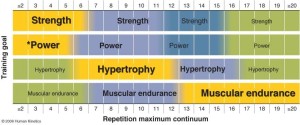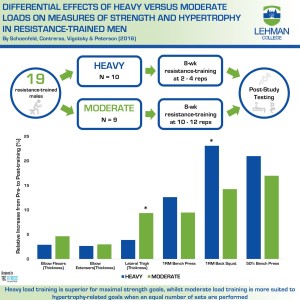
December 5, 2016
What is the Best Rep Range for Muscle Strength and Size?
Dating back to my early years as a personal trainer in the mid-90’s, I began to become intrigued by the concept of “loading zones” whereby different rep ranges purportedly could bring about differential effects on muscular adaptations. Prevailing wisdom at the time was that heavy loads (1-5 RM) promote maximal strength gains, moderate loads (6-12 RM) elicit maximal increases in muscle mass, and light loads (15+ RM) produce the greatest improvements in local muscular endurance. This concept, discussed extensively in exercise science texts, was termed the “strength-endurance continuum” (see the image below) although direct research on the topic was limited.

The topic of rep ranges was so intriguing to me that I ultimately made it a focus of my doctoral work. Several years ago I published the data collected in accordance with my dissertation study. In brief, the study looked at muscular adaptations in a “bodybuilding-type” routine versus a “powerlifting-type” routine in resistance-trained men when the routines were equated for volume load. Consistent with the “strength-endurance continuum” concept, the study found that the powerlifting-type routine produced the greatest strength increases. Contrary to prevailing wisdom, however, both routines produced similar increases in hypertrophy of the biceps brachii. You can read my write-up of the routine in this blog post.
Importantly, the findings of that study are specific to the respective routines being equated for volume load. While this provides interesting insights on the topic, it is impractical to carry out long-term training with very heavy loads at the volumes used in that study (in fact, the majority of subjects in the powerlifting-type group displayed clear signs of overtraining by study’s end). So the question arises as to whether results would differ if an equal number of sets were performed between heavy and moderate loads?
Recently I carried out a study that investigated this very topic. The study was just published in the Journal of Sports Science and Medicine.
Here’s the lowdown.
What We Did
Nineteen college-aged men were recruited to participate in the study. All subjects had at least one year of resistance training experience lifting at least three times per week. Subjects were randomized to either a group that trained in a heavy loading range of 2-4 repetitions per set (HEAVY) or a group that trained in a moderate loading range of 8-12 repetitions per set (MODERATE). All other aspects of the subjects’ program were kept constant between groups. The training protocol consisted of seven exercises that worked all the major muscles of the body each session, with three sets performed per exercise. Training was carried out on three non-consecutive days per week for eight weeks. Subjects were instructed to maintain their normal daily nutritional intake and no differences in either calories or macronutrient consumption was found between groups over the course of the study.
What We Measured
We tested hypertrophy of the elbow flexors, elbow extensors, and quads using b-mode ultrasound. Maximal strength was assessed in the squat and bench press via 1 repetition maximum (RM) testing. Upper body local muscular endurance was determined by assessing the subject’s initial 1RM in the bench press for as many repetitions as possible to muscular failure.
What We Found

The infographic to the left (courtesy of Thomas Coughlin) illustrates the results of the study. In general, overall muscle growth was greater for MODERATE compared to HEAVY. Increases in thickness of the elbow flexors (i.e. biceps brachii and brachialis) modestly favored the use of moderate reps (~5% vs ~3% for MODERATE vs HEAVY, respectively) while gains in the quads substantially favored the moderate rep group (10% vs 4% for MODERATE vs HEAVY, respectively). Interestingly, growth of the triceps was similar between groups.
On the other hand, strength gains were decidedly greater when training with heavy loads. This was seen for improvements in both the 1RM squat (29% versus 16%) and bench press (14% vs 10%), which favored HEAVY compared to MODERATE. Muscle endurance increases were similar between rep ranges.
What are the Practical Implications
The study provides evidence that training with heavy loads helps to maximize muscle strength and training with moderate loads promotes greater increases in muscle mass. Importantly, these findings are specific to routines where the number of sets are equated. At face value, this is consistent with the “strength-endurance continuum” and supports what gym bro’s have been preaching for years in regards to rep ranges.
However, when the results are taken into account with my previous study on the topic that equated volume load, an interesting hypothesis emerges. Since strength gains were greater with heavy loads in both studies, it can be concluded that low-rep training is best for maximizing strength regardless of volume load. On the other hand, since the previous study showed no differences in hypertrophy between conditions when volume load was equated, it can be inferred that volume load is a greater driver of muscle growth irrespective of the rep range. In other words, strength is maximized even with lower training volumes provided heavy loads are used, but higher volumes are needed to maximize gains in size whether you train with moderate or heavy weights.
The study had several limitations including a relatively small sample size, the use of a single-site measurement for muscle growth on each of the respective muscles, and possible confounding from the “novelty factor” (i.e. virtually all the subjects trained with moderate loads, so it is possible that the novel stimulus for those in the heavy load group might have impacted results). These issues must be taken into account when attempting to draw evidence-based conclusions. Most importantly, one study is never the be-all-end-all when it comes to answering questions on an applied science topic. Rather, each study should be considered a piece in a puzzle that lends support to a given theory. The practical implications of programming loading zones will become increasingly clear as we continue to build on this line of research. For now, though, the evidence suggests to train heavy if your goal is maximal strength, and to focus on accumulating volume for maximal gains in muscle mass.
8 Comments
RSS feed for comments on this post.
Sorry, the comment form is closed at this time.





 Entries (RSS)
Entries (RSS)




If the goal is to maximise hipertrophy, do you feel the need to include maximal strength phases? Or just get strong in the 8-12 range?
Cheers!
Comment by Joey — December 6, 2016 @ 3:11 pm
SO it’s the “Pump” vs the “Power” eh? I actually see the correlation with power lifters or olympic weightlifting. Playing football we did short explosive reps with heavier weight not so much 8-12 reps of movements. I’m not “jacked”, but I am strong.
Comment by CrossFit St Petersburg — December 8, 2016 @ 12:03 pm
What were the subjects’ body fat %?
Comment by Chris — December 10, 2016 @ 4:20 am
[…] What is the Best Rep Range for Muscle Strength & Size? […]
Pingback by Fitness Articles of the Week | Webfit Wales — December 11, 2016 @ 9:04 am
Just always killing it with these studies. Keep up the awesome work. I’m super happy that in this day and age of everybody pinching pennies, funding is still happening for these kinds of studies. You’re clearly doing something right.
As a side note, I had to buy a hard copy of “Science and Development of Muscle Hypertrophy” because I liked the Kindle version so much. Something about a real book that just can’t be replicated on a phone/tablet though. I use it extensively when developing programs for my older clients who suffer from sarcopenia (in some cases severe). Very cool that this isn’t just about “looking great naked” but also making positive benefits in the health of others.
Comment by Jason — December 12, 2016 @ 9:05 am
Thanks for the nice sentiments Jason. Glad you enjoyed my book – it was a true labor of love. Cheers!
Comment by Brad — December 12, 2016 @ 10:36 am
[…] Lifting with heavier loads (2-4 reps) results in greater gains in strength than moderate loads (8-1… […]
Pingback by 4 Training Tips To Maximise Muscle Gain - Jerome Rietveld — December 13, 2016 @ 6:30 am
Joey,
I’m going to go out on a limb here and surmise what Brad’s thoughts would be on your question after having read a lot of his work.
You will absolutely benefit from heavy loading cycles in a hypertrophy program because it will make you stronger to lift heavier weights in the more moderate range thus increasing total volume load during the hypertrophy phases.
I personally go heavy for 1-2 weeks before doing more moderate work for 3-4 weeks. Some people even use a daily undulating scheme where one day of the week is heavy and the other days more moderate.
Regardless of how you do it, heavy loading will benefit body composition goals by keeping the volume load moving upwards.
Comment by Jason — December 15, 2016 @ 9:15 am